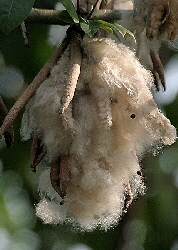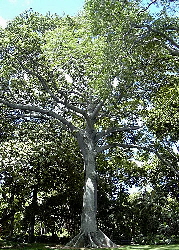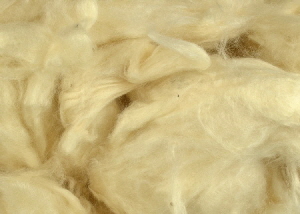|
 The word kapok refers both to the tree and to the fibre it produces, which is also known as silk cotton or Java cotton. The hair-like fibres that surround the kapok seeds are best used as a stuffing, where they have several advantages over more commonly used materials. Kapok fibres on their own are not suitable for spinning into yarn, as they are too smooth, slippery and brittle. The word kapok refers both to the tree and to the fibre it produces, which is also known as silk cotton or Java cotton. The hair-like fibres that surround the kapok seeds are best used as a stuffing, where they have several advantages over more commonly used materials. Kapok fibres on their own are not suitable for spinning into yarn, as they are too smooth, slippery and brittle.
Kapok is similar to cotton in that both fibres are found around the plant seeds, rather than extracted from the stem or leaves.
a) Biology of Kapok
b) Harvesting Kapok
c) Kapok Fibre
d) Future of Kapok
a) Biology of Kapok
Native to Central America, kapok is now widely spread in rainforests around the world and is grown commercially in Java, Thailand and other countries.
Kapok is a majestic rainforest tree that grows up to 60 metres tall and towers over other rainforest trees. This huge tree needs to be stabilized by buttresses, making it very wide and up to 3 metres in diameter. The trunk and large branches often have very large thorns. The canopy supports a large variety of plants and animals.

Kapok sheds its leaves in the dry season, revealing hundreds of 15 cm long leathery pods and small flowers that are pollinated by bats. When mature, the pods burst open revealing a whitish fibre surrounding round brown seeds which are dispersed by the wind.
b) Harvesting Kapok
Harvesting kapok is labour intensive. The ripe unopened pods are normally harvested by knocking them off the tree, but they can also be cut from the tree or harvested when they fall to the ground. Soon after harvest the fruits are hulled and seed and fibre are removed from the pods by hand. The seeds lie loose in the floss and, with the help of some beating they fall to the bottom of the container where they are easily separated. A fully grown plantation tree yields about 15 kg of fibre a year. Kapok is also useful as a source of timber, which is its main current use.
c) Kapok Fibre
Kapok fibres are lustrous, yellowish brown and made of a mix of lignin and cellulose. Each fibre is about 2.5 cm long, has a wide lumen (central cavity) and thin walls covered with waterproof wax. This unusual combination gives kapok some remarkable characteristics.
- Light weight: the hollow core makes kapok very light, 8 times lighter than cotton by volume.
 Buoyant: the waxy coating helps repel water, and air bubbles are usually trapped in lumen, making kapok 5 times more buoyant than cork. Kapok can support as much as 30 times its weight in water. In the past, kapok was used to fill life jackets. Buoyant: the waxy coating helps repel water, and air bubbles are usually trapped in lumen, making kapok 5 times more buoyant than cork. Kapok can support as much as 30 times its weight in water. In the past, kapok was used to fill life jackets.- Bounciness: kapok resists clumping (i.e. it does not become lumpy) it also bounces back to the original shape after washing, a useful property when stuffing soft toys. It is traditionally used for stuffing teddy bears, giving them quite a different feel to modern polyester stuffing.
- Packs down firmly: this characteristic makes kapok useful to stuff meditation cushions.
- Slippery: the waxy coating also makes kapok slippery, it therefore easily adjusts to shape, for example of the head on a pillow.
- Hypoallergenic
- Warm: the cell structure allows it to trap air making kapok a good fibre to use for insulation.
- Environmentally friendly: unlike polyester stuffing, kapok is a natural biodegradable fibre. It can be reused many times without developing mould or decaying.
Kapok has two disadvantages though:
- It is irritant: as the fibres are designed to disperse seeds on the wind, it is advisable to wear a dust mask when stuffing items with kapok, as the fibres fly in all directions and can irritate the lungs.
- It is inflammable: the trapped air makes kapok highly inflammable, and if it catches fire it is difficult to put the fire out. Special precautions are needed to transport kapok in the hull of ships. One advantage of this characteristic is that kapok can be used as tinder.
d) Future of Kapok
The market for kapok fibre used as stuffing has declined considerably over the last 30 years, as it is replaced by polyester stuffing and foam plastics. There is, however, renewed interest in kapok, especially for textile applications.
Developments in technology have made it possible to spin a blend of 3 parts kapok and 2 parts cotton into yarn. Techniques have also been developed to make kapok non-flammable.
Top of page
|

